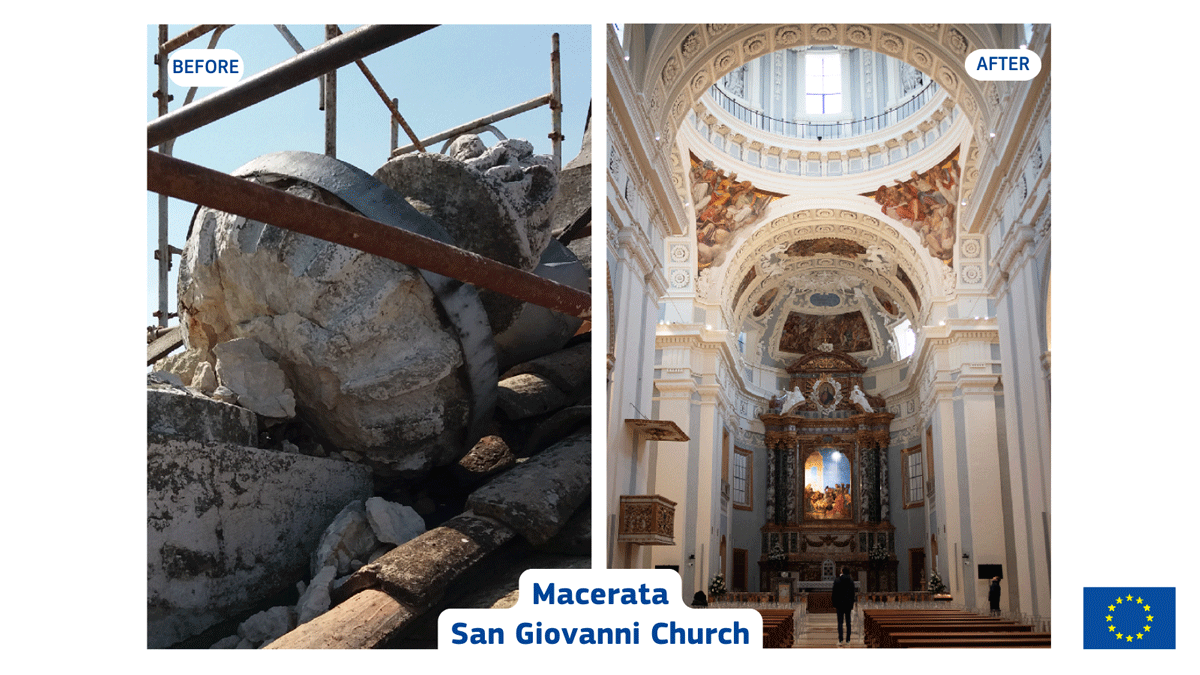
The 2016-2017 Earthquake and Its Devastating Impact
The series of earthquakes that struck central Italy between 2016 and 2017 had devastating effects on the regions of Marche, Abruzzo, and Umbria. These events caused significant loss of life and widespread destruction. For the local communities, the destruction of infrastructure and buildings led to severe economic difficulties, making the return to normal life even more challenging.
European Support for Reconstruction and Recovery
In response to this tragedy, the European Union provided substantial funds to support the reconstruction and recovery of the affected areas and to help revive the local economy. These European funds have proven to be a crucial catalyst for economic revival and a long-term sustainable recovery. Unlike other recent interventions where the EU used the European Union Solidarity Fund (EUSF), in central Italy, resources were allocated through the European Regional Development Fund (ERDF). These funds were used for a wide range of projects, including the reconstruction of public buildings, restoration of cultural heritage, improvement of transport infrastructure, and promotion of local economic development. The management and allocation of these funds were a result of collaboration between the European Commission and local and regional authorities, ensuring targeted and effective interventions.
Key Interventions and Investments in Marche
In the region of Marche, the 2016 earthquake affected an area covering four provinces, causing damage in 85 municipalities, many in the Apennine hinterland. The EU allocated an additional €240 million to prevent seismic and hydrogeological risks and promote energy efficiency. Specifically, 39% of the funds were used to support the competitiveness of Small and Medium Enterprises (SMEs), and another 39% was invested in the seismic efficiency of university and healthcare buildings. For example, the Amandola hospital received an investment of €31 million, with €15.6 million from the ERDF. European funds also helped revive Marche's cultural heritage, such as the Collegiata San Giovanni in Macerata, which reopened to the public in 2022 after 25 years, thanks to €3.2 million in funding. Educational buildings also benefited, including projects at the Ente Diritto allo Studio Marche (ERDIS) and the University of Macerata.
Safety and Territorial Enhancement in Abruzzo
Abruzzo also suffered from an earthquake in 2016, followed by catastrophic weather events in 2017. This region's geography and the cyclical nature of such events necessitate interventions to prevent seismic and hydrogeological risks. European funds were allocated to secure the territories in the municipalities of Pizzoli, Civitella del Tronto, and Castelli. These projects, funded with nearly €5 million, aimed to reduce landslides and mitigate hydrogeological risks. In Civitella del Tronto, the intervention also preserved the natural and cultural heritage, including a medieval village and a sixteenth-century fortress. These projects have made the communities safer and allowed the resumption of economic activities, including tourism.
Reconstruction and Sustainable Development in Umbria
With the help of European regional development funds, Umbria invested about €43 million in various interventions in the earthquake-affected areas and across the region to ensure comprehensive and consistent prevention. The actions aimed to recreate the socio-economic and environmental conditions before the 2016 earthquake. These included the safety and energy efficiency of public and school buildings, promotion of tourism, and preservation of cultural and natural heritage. The reconstruction of the Basilica of San Benedetto in Norcia is a symbolic example of using European funds efficiently to safeguard cultural heritage. Efforts to enhance tourism also included the improvement of the Norcia-Castelluccio and Roccaporena trails. The UmbriAperta initiative supported many hospitality structures in the region, aiding their recovery from the 2016 earthquake. The regional investment plan also focused on the service sector, benefiting companies involved in social services, digitalisation, and event organisation.
Collaboration and Vision for the Future
The reconstruction in Marche, Abruzzo, and Umbria after the earthquakes and natural disasters exemplifies successful collaboration between regional actors and the European Union in ensuring safety, prevention, and economic recovery for local communities. The case of central Italy demonstrates the foresight of European funds in addressing the economic and social needs of the territories, promoting growth, and ensuring prevention against hydrogeological risks. These investments have enabled the affected regions to start a process of recovery and rebirth, improving residents' quality of life and laying the foundations for long-term sustainable development. The cooperation between the European Union and local authorities has shown how community support can make a difference in times of crisis, providing not only financial resources but also a vision for the future.